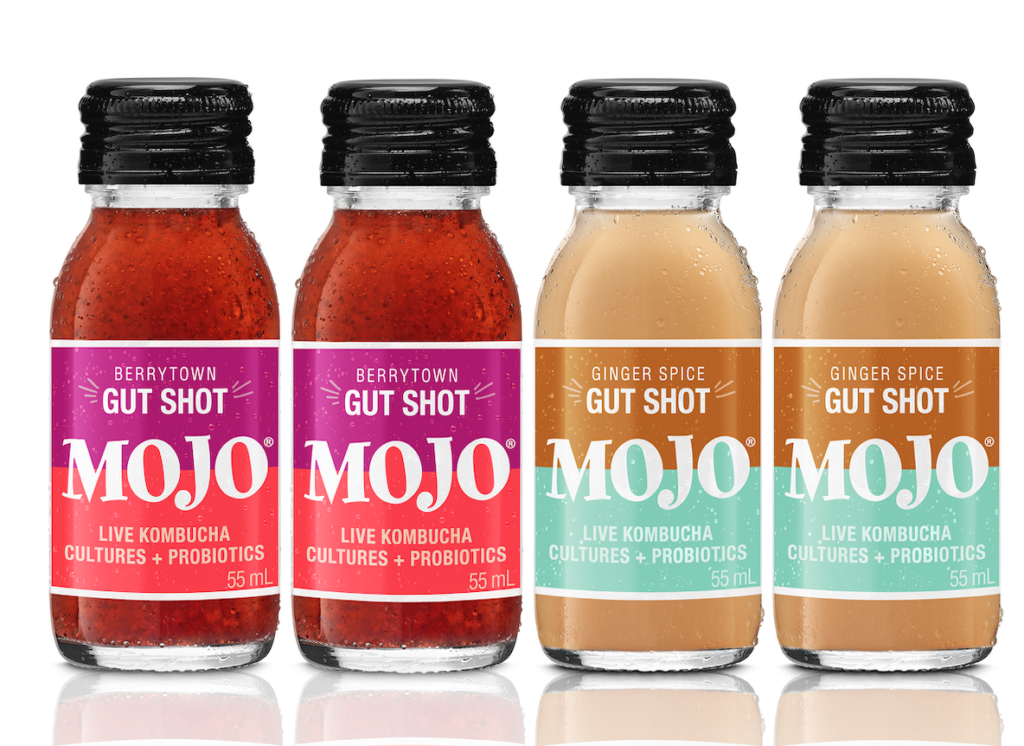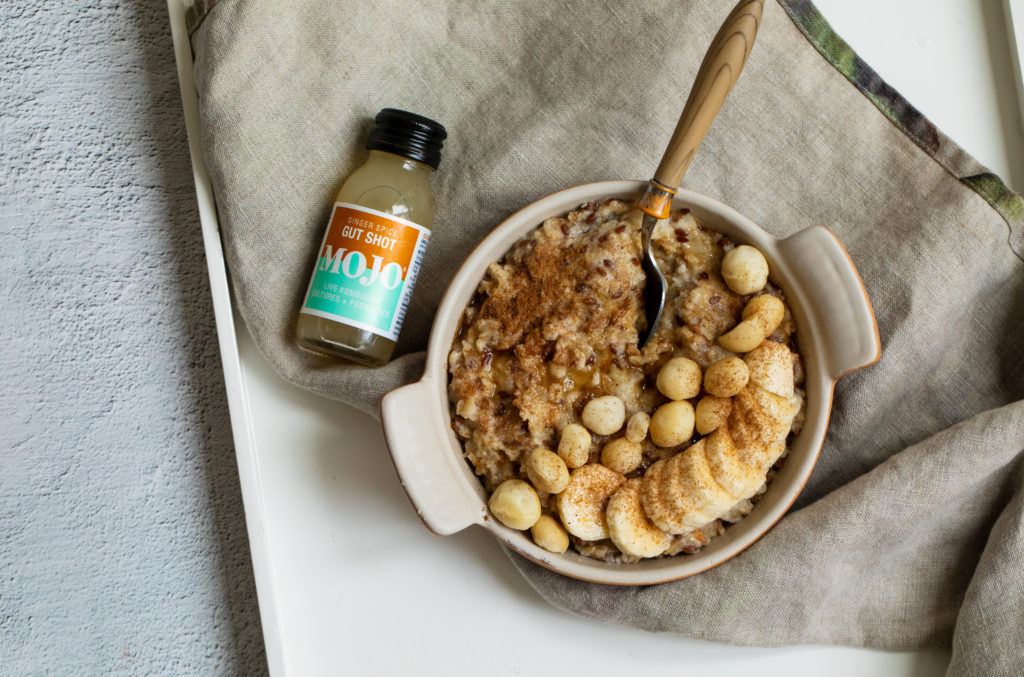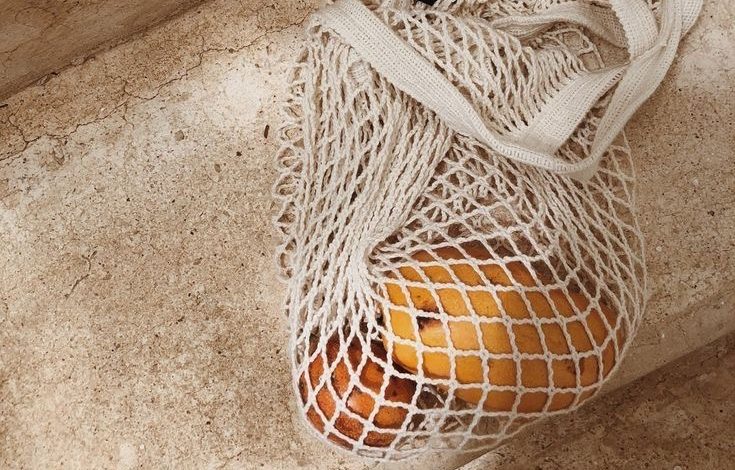Improved gut health is linked to healthier skin, hair, and nails, better mental health, improved sleep, and more…
These days it’s easier to incorporate good food for gut health into our diets, for example, MOJO Kombucha has launched a new Gut Shot, which can be added to smoothies, blended with fresh juice, or sipped straight up for a daily dose of probiotic goodness.

Nutrition scientist and dietitian Dr. Joanna McMillan shares with CF her 5 top tips for great gut health along with one of her fave recipes to make at home these days.
My goal is to inspire individuals and give the information needed to embrace a healthy, active lifestyle. One where you love to eat well & choose to live this way not because you think you should, but because you know that when you do, you look and feel your absolute best, and you can give and get more out of life. Joanna says.

Joanna’s 5 Top Tips For Gut Health
1. Fuel your healthy gut bugs with fibre
You need to feed yourself the nutrients your body needs, but you also need to feed your gut bugs. The best fuel to encourage the growth of the friendly, beneficial to our health microbes is fibre. Without enough fibre, you effectively starve these good bugs, leaving room for less healthy gut bugs to dominate.
Eating plenty of fibre encourages the growth of bacteria that produce a short-chain fatty acid called butyrate. This is a key indicator of gut health. Butyrate has a number of benefits. Firstly, it is the major fuel of the cells lining the colon, keeping them healthy and reducing the risk of cells turning cancerous. It is also anti-inflammatory and assists with ensuring the entire gut barrier work as it should. It also acts on the liver helping to control both blood glucose and cholesterol.
One of the best fuels for butyrate-producing bacteria is a special type of fibre called resistant starch. You’ll find it in firm bananas, many whole grains including oats and barley (especially consumed raw or soaked e.g. overnight oats are terrific), legumes (think beans, peas, lentils, and chickpeas), and starchy foods like potatoes, pasta, or rice that have been cooked and cooled. Note that you can eat them cold in a salad or reheat them, that won’t break down the resistant starch.
In addition, you want both soluble and insoluble fibres. Some of these are fermented by the microbiota, some assist with regularity so you don’t get constipated and some help with achieving the right rate of digestion so that every section of your gut is used as it should be.
2. Go for plant food diversity
To achieve all these different types of fibre, you need to eat lots of different plant foods. Think of them in groups: whole grains, legumes, fruit, vegetables, nuts, and seeds. Daily your goal is to eat a minimum of 5 different veggies, 3 whole grains, 2 fruits, and a handful of nuts (or seeds). Then include legumes every other day. For those with higher energy needs you can eat more than this, but for most adults, this is our minimum to meet nutrient needs.
Then think about the diversity of your plant foods. Do you always buy the same foods week in week out? The goal is at least 30 different plant foods across the week. Try making a list over the coming week and see if you get there.
Include different colours of fruits and veggies to ensure a broad intake of phytochemicals like antioxidants. One group that seems to be particularly important are polyphenols as these are utilised by the microbiota. Some researchers are even including polyphenols as prebiotics since they boost the growth of certain beneficial bacterial groups. You’ll find polyphenols in many plant foods and drinks made from them including:
- Berries, cherries, apples, plums, avocado, tomatoes
- Dark leafy greens like silverbeet, red onions, artichokes, red cabbage, broccoli, capsicum, beetroot
- Herbs & spices
- Cocoa powder and dark chocolate, black and green tea, coffee, red wine
- Black beans, black rice, soybeans, and soy products like tofu and tempeh
- Nuts (hazelnuts, walnuts, and pecans are especially high)
- Extra virgin olive oil, olives, and olive leaf tea

3. Drink plenty of water
Many fibres absorb water in your gut and this is part of how they work to keep you regular and the intestinal contents moving along. They absorb water, swell and that pressure on the intestinal walls stimulates the gut muscles to contract. Without enough water, your body will pull some from your body into the gut, but that can leave you dehydrated.
If you’ve ever felt thirsty after eating whole grain bread that is what is happening! But it’s also why you sometimes feel very full half an hour to an hour after eating a very high fibre meal. You think the fibre makes you bloated, but actually it’s doing what it is supposed to do. If you really feel too full it may mean that you ate too much… this is, in part, how high fibre foods help with weight control. They help you to feel fuller and stave off hunger pangs for longer.
You need to drink at least 8 glasses a day – think of one every hour – but more if you are exercising, sweating on a hot day, or sitting in air conditioning.
4. Exercise daily & limit sitting time
When you are sedentary, so is your gut. Yes, you want to sit for a little while after a meal to allow the food to start emptying from your stomach, and certainly, before vigorous exercise, you are best not to eat for a couple of hours. But once the food has left your stomach, or at least not much is left, exercising is a good thing as it stimulates the rest of the gut to contract and get things moving.
If you struggle with constipation, try having a big glass of water when you get up in the morning and immediately going for a walk. Coffee can also sometimes help to stimulate the gut to contract but be aware it can be a gut irritant for others.
The rest of the day try not to sit for too long. While we are all spending more time at home during the pandemic, look for activities you can do. Spring clean your house, wash the car, potter in the garden, clean your windows, do an online yoga class or workout, and get busy in the kitchen!
5. Include fermented foods and drinks
These are not just a passing fad. Fermented foods and drinks have been around for centuries and recent research is showing that they are good for gut health too. Some contain probiotics, like a good quality kombucha, some have prebiotics too like kimchi and
sauerkraut and others just have the products of the fermentation process, including organic acids, such as sourdough bread. Even without the live bacteria and other microbes, these acids and other products of fermentation seem to be good for the gut.
Joanna’s Recipe: Kickstarter Smoothie
Packed with probiotics and prebiotics, this smoothie will help to kickstart your morning and your gut health!
General FAQS
How do I detox my gut?
Limit Alcohol.
Focus on Sleep.
Drink More Water.
Reduce Your Intake of Sugar and Processed Foods.
Eat Antioxidant-Rich Foods.
Eat Foods High in Prebiotics.
Decrease Your Salt Intake.
Get Active.
Is coffee bad for your gut?
According to scientific literature, drinking coffee is beneficial for gut health. It helps improve bowel movement by increasing the motility of smooth muscle in the gastrointestinal tract.
You’ll also like this:
When Your Skin Talk About Your Gut
Are You Ageing Faster? Your Gut Might Be the Key! And Kirsten Scott Shares With CF Why








